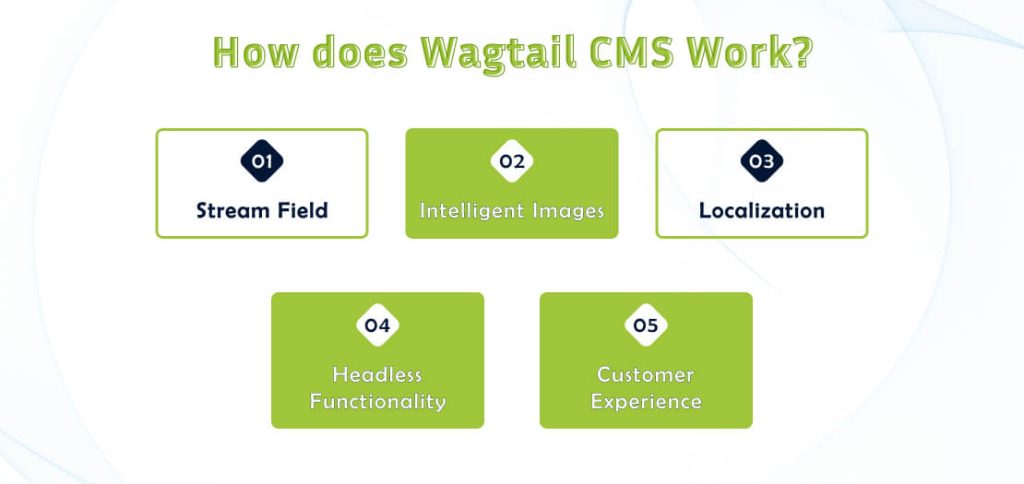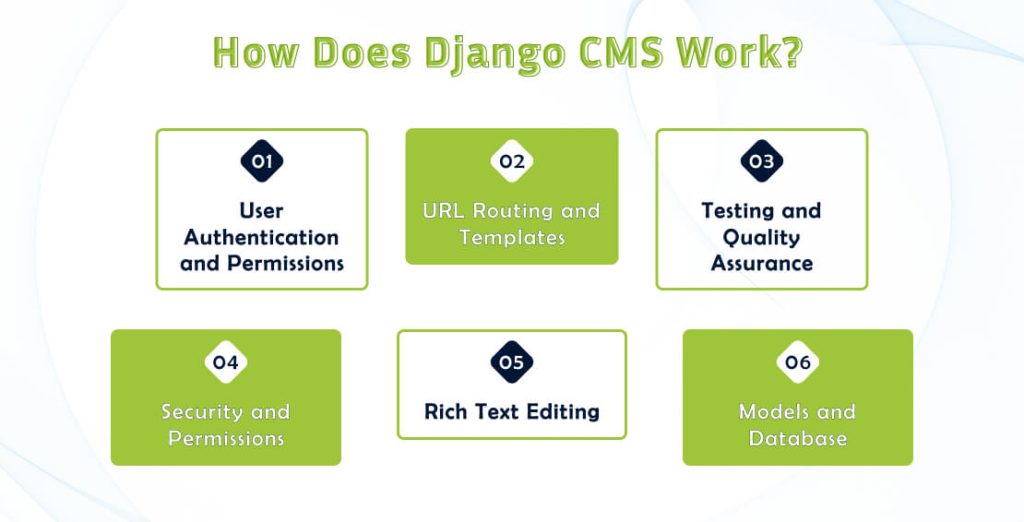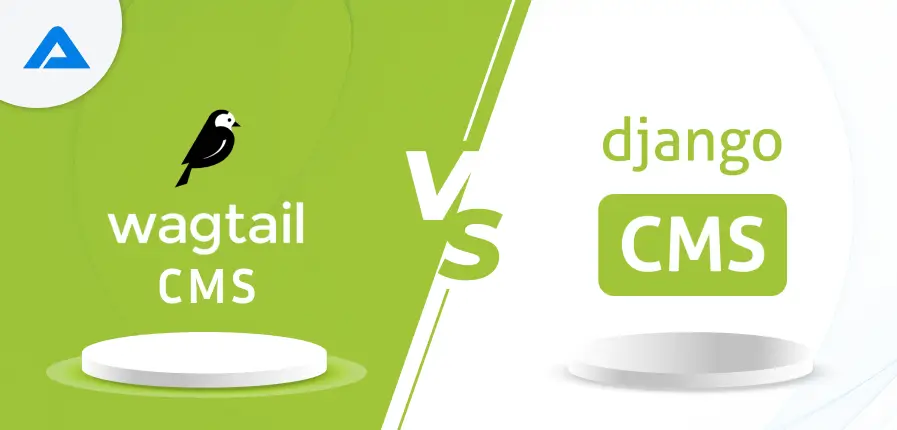If you are building websites using Python, There are a variety of frameworks that you can choose from. One of the most well-known is Django. You can develop a website from scratch using Django’s framework or utilize an existing CMS. (CMS).
The choice of the best CMS for Django is challenging because there are many options available, such as Mezzanine, Butter CMS, Pinax, Hygraph, and others. Two of the most popular choices include Wagtail CMS and Django CMS. Both offer a variety of distinctive features and an easy integration with Django; however, they cater to slightly different requirements.
In this article, we’ll look at Wagtail CMS and Django CMS, covering their capabilities, performance, and how they compare.
What is a Wagtail CMS?
Wagtail is a popular and well-known Content Management System. What is a content management system (CMS)? A CMS is web-based software that provides website administrators with an easy-to-use interface to design, edit, and publish web pages that include blog posts, images, and videos.
CMS is a better alternative to writing everything in static HTML. CMS can provide a more straightforward method of managing a website, make it easier to maintain a website, and ensure that the more dynamic elements of the website can be handled by administrators, even if they could be more technically adept.
Wagtail CMS is an open-source application built using the Django Web Framework. The Django Web Framework is Python-based, which makes it quick and easy to create. This means that websites of any size can be created swiftly and effectively, saving time and money.
How does Wagtail CMS Work?

Unlike other content management systems, the Django Content Management system (Django CMS) offers a simple user interface with simple-to-use adjustments. Django allows for easy modifications. Content managers can select tools derived from programming, such as Python classes or blocks.
Wagtail is a streamfeil-based CMS that provides intelligent images, a better customer experience, and headless functions. Adding new and unique features shouldn’t be a hassle when using the Wagtail CMS Development Services.
Stream Field
The stream field function in Wagtail CMS lets you create block-by-block blocks of a website page using the drag-and-drop feature. Blocks can be arranged in any order desired by the administrator.
Intelligent Images
The intelligent images feature is compatible with Clever digital image editing. The system built into it can effortlessly modify the images to ensure your site appears tidy and gorgeous.
Customer Experience
This is the most vital function of Django CMS/WagtailCMS. It allows admins to test several pages using A/B testing, which is crucial to discovering which pages are effective from a UI perspective.
Headless Functionality
Using the Wagtail Builder API, any Javascript front end can be created. Headless technology is ideal for creating web pages for websites of any kind.
Localization
With Wagtail’s localization, administrators can benefit from the localization options built into WordPress. This lets your website display in various languages to meet users’ preferences.
If you’re a developer marketer or a content creator, our knowledge and resources are available to help you.
Features of Wagtail CMS
Many options in Wagtail CMS should be overlooked because of their importance and capability to create an excellent website.
Editing Features
- The preview feature lets you look at the site’s preview to check for any modifications being made to the website.
- The table with a WYSIWYG Rich-Text Editor is challenging to navigate. However, with Wagtail CMS, the separate block editor solves this problem.
- Automated revisions are not going to disappear. The revisions are automatically saved and are later used.
- The uploading and cropping features let you create high-quality thumbnails.
- Innovative copy-and-paste feature that does not require worrying about the style issue on the Wagtail website development.
- You can build a one-page form with the Wagtail CMS.
Administrative Features
- Wagtail lets you add diverse groups of users who have different rights.
- Developers can create searchable fields and define the relevant model field.
- Elastic search is utilized to search for content within the administration interface.
- The refined workflows for content are available to editors and owners of content.
- It is possible to manage multiple sites using the same administration interface.
- Content areas that can be edited on the site can be altered using the site settings module.
- Utilize the Wagtail API access and read JSON, a read-only API.
- It is compatible with other Django applications with no hassle.
Performance
- Wagtail is exceptionally lightweight in appearance and can enhance performance all in one.
- Wagtails cache invalidator module assists by delivering real-time updates to display real-time content.
- You can easily create static websites for the Django bakery and the Wagtail bakery.
Community
- Wagtail CMS is a community of users who offer solutions for every issue it comes across.
- Test coverage reactions of Wagtail CMS are distinctive. Wagtail has a unique 95% test coverage ratio.

Transform Your Website Today! 🌐 Explore our Wagtail development services and see how we can bring your vision to life. Request a free demo now!

Pooja Upadhyay
Director Of People Operations & Client Relations
Use Cases of Wagtail Python-based CMS
Despite its growing popularity with other Wagtail CMS like WordPress, Joomla, and Weebly, many users still prefer Wagtail because of its benefits.
The Need for Simplicity: Managing multiple CMS systems to manage different websites can be challenging. Wagtail allows for the convenience of managing all websites within one CMS. It is popular with people who require a light CMS that is not cluttered with many features.
Development flexibility: Hire Wagtail Developer to modify technical issues without worrying about code. Thus, those looking for high-end, customized websites choose Wagtail.
Database Control and Query: The system speeds up the website since the administrator has complete access to query and database management within the Wagtail Content Management System.
What is Django CMS?
Django is an open-source framework for creating websites based on Python. It is a Django framework for web development that is perfect for creating robust websites; however, it isn’t equipped with an effective system for managing content.
Django CMS is an add-on to Django, and CMS is a term for an information management system for content that offers missing functionality.
How Does Django CMS Work?

Django is an excellent option for creating a content management system (CMS) because of its robust framework and built-in features that simplify the creation of complex web-based applications. Here’s how to utilize Django to build a CMS:
Project Setup
Start by developing a new Django project or by integrating an existing CMS into an existing project. You can build a new project using the Django admin start project command.
Models and Database
Determine your content models with Django’s CRM. These models represent the different types of content that you would like to manage, including images, articles, or videos. Ensure your models are correctly structured with connections to manage various content and features.
Admin Interface
Django offers a robust administrator interface right from the beginning. You can modify it to allow content creators and editors to manage content efficiently. Make the admin site customizable to fit your CMS’s brand and design.
User Authentication and Permissions
Create user authentication and permit systems to restrict who can write and edit content. You can utilize Django’s built-in authentication system and modify permissions customarily to limit access to specific actions.
Rich Text Editing
To manage textual content, incorporate a text editor like CKEditor and TinyMCE. Django applications like django-ckeditor simplify integrating editors like these into your CMS.
Media Handling
Configure Django to handle media files like videos and images. Use the MEDIA_URL and MEDIA_ROOT settings to define the location where uploaded files are stored and served.
URL Routing and Templates
Create URL patterns that display various types of content. Use designs to display the information. Utilize Django’s template system to ensure consistency in style and layout.
Version Control
Implement a version control process to control changes to content. You can accomplish this by creating a history of versions of your content models and allowing editors to roll back to earlier versions as needed.
Search Functionality
Integrate search capabilities to assist users in finding content quickly. Django applications like Elasticsearch and Django Haystack can be used to create comprehensive search capabilities.
Security and Permissions
Ensure that your CMS is secured using proper security measures, including input validation, the eviction of user-generated content, and stopping common security flaws such as Cross-Site Scripting (XSS) and Cross-Site Request Forgery (CSRF).
Testing and Quality Assurance
Conduct a thorough test of your CMS’s functionality to verify its reliability and performance. Automated tests can detect and avoid regressions when you introduce new features.
Deployment
Set up your Django CMS production server or infrastructure with a hosting service provider. You can configure your website server (e.g., Nginx or Apache) and database server (e.g., PostgreSQL or MySQL) for maximum performance.
Features of Django CMS
Django CMS is a solution with many features that include:
Rapid: Development is speedy. Fast: With Django, you can build your website quickly, from initial ideas to production, within the shortest time possible. This is achieved with the help of already-built libraries like ORM for database models.
Security: Django makes sure that developers do not make naive security errors.
Scalable: The Django project consists of small, pluggable apps. Each of these applications is easy to integrate into the project’s main.
Multifaceted: Django is a versatile framework that lets developers build any site, from eCommerce to social media to academic websites.
Rapid Prototyping: Rapid prototyping allows the fast creation of prototype websites, permitting users to rapidly iterate and visualize their concepts before fully implementing them.
Highly Customizable Features: It allows users to modify the content structure, templates, and functions quickly and flexibly to meet various project requirements.
Scalable: Architecture allows for rapid expansion and growth, ensuring the highest performance as applications and websites grow in size and complexity.
High-Security Version: The high-security version offers built-in solid security and best practices for protecting websites from potential vulnerability and unauthorized access.
Unique Validation of Data: It ensures data accuracy and integrity through rigorous validation, improving overall quality and reliability.
Individual User Permissions: It allows administrators to manage access levels, providing individualized and secure content management for various users with different roles.
Open Source: Django is a free, open-source web platform that allows anyone to develop web-based applications more quickly.
Extensible: Developers will have access to all the power and flexibility of the pip package manager. So, anybody can install any Django application, such as Django REST. Django REST framework to create REST APIs.

Default Features: Django has all the necessary features to build an intricate web-based application. Let’s say you wish to develop a database-based program. In that scenario, it comes with user interaction models and aids in creating a stunning user interface based on the models and migrations.
Use Cases for Django CMS
Django CMS offers a scalable platform that can be used for various projects:
Corporate Web Sites: Many companies opt for Django CMS as their official website because of its ability to manage complicated content structures and integration.
E-commerce Websites: With the proper plugins, Django CMS will power E-commerce platforms, allowing customization and scale to online shops.
Newspaper Portals: Media companies typically choose Django CMS because it supports multiple languages and can manage content.
Education Platforms: The Django CMS could easily create educational websites and learning management systems.
Wagtail vs. Django CMS
After briefly reviewing the overviews we examined for Wagtail and Django CMS, let’s discuss how these choices compare across various fields.
User Interface
Wagtail is a sleek, contemporary interface that simplifies content management tasks. The editing feature lets users modify pages directly, increasing efficiency.
Django CMS offers a customizable dashboard with drag-and-drop functionality to arrange content elements. It is a more conventional user interface.
Learning Curve
Wagtail excels due to its drag-and-drop interface for content blocks, which makes creating content simple to implement. It also offers an easier learning curve for editors since the abstractions are easy to understand, while the manual is simple to read and navigate.
The learning curve of Django CMS is a bit steeper. Due to its plugin-based design, it requires some experience for non-technical users. Django CMS gives users an alternative to the traditional editor experience, which can be enhanced by plugins to meet the needs of advanced editors.
Flexibility
Wagtail is a flexible and adaptable software for modeling content, allowing developers to design customized content types efficiently. It provides a hierarchical page structure that easily organizes content into an a-like tree structure.
In addition, Django CMS offers an extensive plugin ecosystem that allows developers to build on functionality seamlessly.
SEO and Performance
The two, Wagtail and Django CMS, are well-known for their performance excellence. Both focus on SEO (search engine optimization) through features such as customizable metadata. XML website map creation, as well as clear URL structures.
Wagtail’s performance is enhanced by its optimized database queries and caching mechanisms. It allows caching via Redis and uses Elasticsearch to give users the most advanced content search capabilities.
Django CMS is designed to scale quickly, which makes it ideal for websites with high traffic. Its caching options can minimize performance bottlenecks and provide advanced caching strategies using tools like Django Redis. Additionally, its modular design lets developers maximize performance by caching only certain content components.
Community Support/Ecosystem
With more than 17.7k stars on GitHub, Wagtail has gained popularity over the past few years and has a vast and fast-growing community. The advantages of this large community are reflected in the excellent tools and tutorials readily available to aid in your development. The framework’s documentation doesn’t get absent either since it is updated regularly with any advancements.
On the contrary, Django CMS has 9.9k stars and an established community. This Django CMS community has been active longer than Wagtail, which is why it’s bigger and has more assistance and support.
Conclusion
The decision to choose the right one from Wagtail or Django CMS depends on the particular needs of your project, as well as the technical skills of your team.
If you are looking for a simple, user-friendly interface and the flexibility of content modeling, Wagtail may be the best choice. However, Django CMS could be more suitable if you need extensive customization capabilities and a modular approach to managing content.
Whatever you pick, Wagtail and Django CMS are both powerful CMS choices that enable developers to build unique web experiences using Django and Python frameworks.

Ready for a Cutting-Edge Website? 💡 Schedule your Wagtail development demo and see firsthand how our solutions can drive success for your business!

Pooja Upadhyay
Director Of People Operations & Client Relations

